Chapter 6a: Persuasive Strategies in Sustainability Messaging
Objectives
By the end of this chapter, students will be able to:
1. Identify the role of persuasion in business sustainability.
2. Label components of a persuasive message such as attention-getter and call to action.
3. Analyze benefits, motivation, and reinforcement strategies.
4. Add counterarguments and refutations to strengthen arguments.
5. Differentiate between appeals such as logos, pathos, and ethos.
6. Label and avoid logical fallacies.
7. Revise logical fallacies to more credible arguments.
8. Present arguments and provide constructive feedback.
Introduction
Persuasion is a critical method of communication in business sustainability, where speakers or writers aim to convince others to adopt certain viewpoints or actions. The outcome of successful persuasion is motivation, inspiring listeners or readers to think or act in a new way. [1] This chapter will use persuade, convince, and motivate interchangeably. While persuasion can be used for noble purposes, it can also be manipulative or utilized for unethical goals.
The Role of Persuasion in Business Sustainability
In the business environment, persuasion is essential for motivating change, gaining stakeholder support, overcoming resistance, and enhancing brand reputation. It plays a vital role in promoting sustainability by changing behaviors, building support, creating awareness, and fostering partnerships. [2]
Changing Behavior. Sustainability often requires significant changes in behavior, such as reducing energy consumption or adopting eco-friendly practices. Persuasion can highlight the benefits of these changes, address concerns, and provide compelling reasons to take action. [3]
Building Support. Effective persuasion helps build support for sustainability initiatives among stakeholders including employees, customers, investors, and the community. By presenting a persuasive case, businesses can rally support and generate enthusiasm for their environmental efforts. [4]
Overcoming Resistance. Resistance to change is common, especially when new practices or sustainability measures involve upfront costs. Persuasion techniques can address objections, alleviate fears, and emphasize long-term benefits, such as cost savings and environmental stewardship. [5]
Creating Awareness. Persuasive communication raises awareness about sustainability issues and their implications for businesses and society. By effectively communicating the urgency and importance of sustainability challenges, businesses can inspire action and motivate individuals to make environmentally conscious decisions. [6]
Enhancing Brand Reputation. Consumers increasingly prefer companies that demonstrate a commitment to environmental responsibility. Persuasive communication about sustainability initiatives can enhance a company’s brand reputation, positioning it as a socially responsible organization. [7]
Gaining Competitive Advantage. Businesses that effectively communicate their sustainability efforts can gain a competitive advantage. Persuasion can differentiate a company from its competitors, attract environmentally conscious consumers, and appeal to investors who prioritize sustainable investments. [8]
Fostering Partnerships. Persuasion is instrumental in fostering partnerships and collaborations with other businesses, organizations, and government agencies to address sustainability challenges. Articulating a compelling vision for sustainability and the benefits of collaboration can engage partners in joint efforts to achieve common environmental goals. [9]
Audience Analysis: Who You May Have to Persuade
Business communicators must address environmental sustainability with a variety of audiences for several important reasons. Each audience plays a unique role in the broader ecosystem of the business and has distinct interests and influences. See a visual below of who is involved when communicating about sustainability. A detailed description is in the footnote.
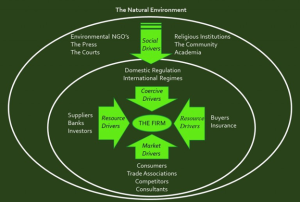
Within the firm. Communicating sustainability to employees and management ensures that everyone is aligned with the company’s sustainability goals. This alignment fosters a culture of responsibility and can motivate employees to contribute actively to sustainability initiatives. Regular communication helps educate employees about sustainability practices, making them more likely to implement and support these practices in their daily work.Layers and Drivers:
- The Natural Environment:
- This is the outermost layer, indicating the overarching context in which the firm operates.
- Social Drivers:
- These drivers are depicted as an arrow pointing towards the firm from the top.
- Social drivers include:
- Environmental NGOs
- The Press
- The Courts
- Religious Institutions
- The Community
- Academia
- Coercive Drivers:
- Positioned directly above the firm and depicted as an arrow pointing downwards.
- These drivers include:
- Domestic Regulation
- International Regimes
- Resource Drivers:
- Positioned to the left of the firm and depicted as an arrow pointing rightwards.
- Resource drivers include:
- Suppliers
- Banks
- Investors
- Market Drivers:
- Positioned below the firm and depicted as an arrow pointing upwards.
- Market drivers include:
- Consumers
- Trade Associations
- Competitors
- Consultants
Other Elements:
- Buyers and Insurance:
- Positioned to the right of the firm, suggesting their role as drivers influencing the firm.
Overall Structure:
- The concentric circles and arrows illustrate that the firm is at the center of a network of influences from various drivers categorized into social, coercive, resource, and market factors. Each category influences the firm’s operations and decision-making processes within the context of the natural environment.
Within the firm. Communicating sustainability to employees and management ensures that everyone is aligned with the company’s sustainability goals. This alignment fosters a culture of responsibility and can motivate employees to contribute actively to sustainability initiatives. Regular communication helps educate employees about sustainability practices, making them more likely to implement and support these practices in their daily work. [11]
Domestic and International Regimes. Suppliers need to understand the company’s sustainability standards to ensure that their practices align with these standards. This alignment can enhance the overall sustainability of the supply chain. Banks and investors are increasingly interested in funding sustainable businesses. [12] Clear communication about sustainability efforts can attract investment by demonstrating the company’s commitment to long-term, sustainable growth and risk management. [13] Businesses can foster positive relationships with NGOs, potentially leading to partnerships and collaborative initiatives. [14] Customers today are also more environmentally conscious and prefer to support businesses that demonstrate a commitment to sustainability. Transparent communication about sustainability efforts can build brand loyalty and trust. [15] In addition, many religious institutions and community groups emphasize ethical and responsible stewardship of the environment. Communicating sustainability efforts to these groups can align the company with broader ethical and moral values, enhancing its reputation. [16] Lastly, collaborating with academic institutions can provide access to cutting-edge research and innovation in sustainability practices. Communication with academia can lead to joint research projects and advancements in sustainable technologies. [17]
In sum, business communicators must address environmental sustainability with a variety of audiences because each group has a distinct role and influence on the business’s sustainability efforts. Effective persuasion with a variety of readers and listeners ensures alignment, builds trust, attracts investment, fosters partnerships, and enhances reputation. It also meets the growing demand for transparency and accountability in environmental practices, ultimately contributing to the long-term success and sustainability of the business.
Persuasion Techniques for Sustainability
Persuading Colleagues. Companies are demanding more information, setting higher standards, and pushing suppliers to place climate and human rights demands on their suppliers. Some use the “stick”, punishing people for less-friendly environmental practices. [18] For example, Salesforce “asked” its suppliers to set science-based targets and help be more sustainable, or risk paying a fine. Others try the “carrot”, or provide benefits to those who conduct business in an eco-friendly way. For example, Tesco and Santander teamed up to offer suppliers better rates for improving their businesses on sustainability goals. [19]
Persuading Consumers and other Stakeholders. Persuasion techniques can effectively promote sustainability by showing how easy and budget-friendly eco-friendly practices can be, and by highlighting their importance without manipulation. The following are tips on how to persuade audiences about planetary sustainability from “Our Good Brands”: [20]
- Show Them How Easy It Is. Explain that adopting sustainable practices doesn’t have to be complicated. Provide simple steps and examples to demonstrate how easy it can be to live sustainably.
- Show Them Budget-Friendly Options. Highlight cost-effective ways to live sustainably, such as growing food or shopping at second-hand stores. Emphasize that sustainability can be affordable.
- Show Them How Important It Is. Use persuasion, not manipulation, to show the significance of sustainability. Share your environmental convictions and concerns to inspire others to join the effort.
Below is an image of a note that was included in someone’s package that says “stay eco-conscious!” with other information in smaller text on how and why.

John Monroe developed a series of steps in the 1930s that he believed were essential for persuading individuals. These steps are Attention, Need, Satisfaction, Visualization, and Action. [22]
- Attention. To get someone’s attention, you need to engage them within the first few seconds of your argument. Techniques include bringing up a passionate topic, making a benefit statement, or providing a startling fact.
- Need. Once you have attention, keep it by demonstrating the need for continued listening. Understand what is important to the listener and focus on those concerns.
- Satisfaction. Describe how your position will meet the need addressed in the previous step. Explain the benefits and how your solution solves the problem or avoids negative consequences.
- Visualization. Create a picture for the listener of what the situation will look like once they agree with you. Use descriptive language to help them visualize the positive outcomes of adopting your position.
- Action. Once agreement is near, suggest the next steps to put your solution into motion. Prompt action quickly to prevent the listener from reconsidering.
Below is a visual of the “motivated sequence.” It shows the hook pointing to the need, then solution, visualization, then action. Under “hook” it also has the word “punch.” Under “need” it says “problem cause.” Under “solution” and “visualization” it has “ethos, pathos, logos, success.” Under “action” it says “recap” and “call to action”:
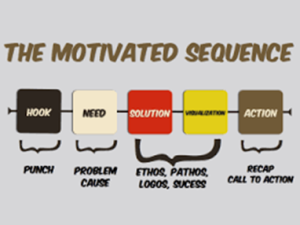
Cardon (2018) outlines the components of internal and external persuasive messages with similar components [24]:
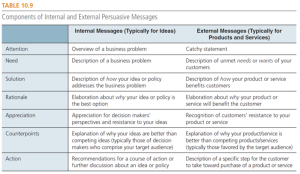
Effective attention getters include stories, testimonials, facts/statistics, showing timely relevant goodwill (“Fun indoors during this rainy season!”), appreciation statements, and compliments. The following are examples of poor attention getters:
- Beginning with the request or other information that the audience may resist right away
- Donate $20 to benefit our animal shelter!
- Exaggerations
- Best offer that ever existed!
- Use vague phrases
- Solution to your problem is here!
- Use spam-like phrases
- Earn $100 cash immediately just click here! [25]
Patagonia’s ad found on an outside pole grabs the audience’s attention and inspires action by reading the lines from top-to-bottom (as we do naturally) then encouraging the reader to read this bottom-up:
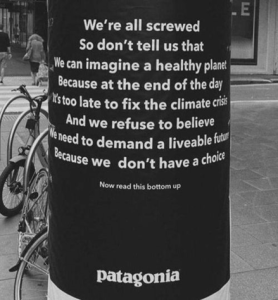
Benefits, Appeals, and Reinforcement Strategies
Persuasion in the context of business sustainability involves planning messages for different types of motivation. By recognizing how intrinsic and extrinsic motivations, variety of appeals, tangible and intangible benefits, and positive and negative reinforcement operate, businesses can effectively promote sustainable practices among employees and stakeholders.
Intrinsic vs. Extrinsic Motivation
Motivation is a critical element in persuasion, influencing how individuals respond to sustainability initiatives. There are two primary types of motivation: intrinsic and extrinsic.
Intrinsic Motivation is driven by internal rewards and personal satisfaction. When individuals engage in behavior because they find it inherently interesting or enjoyable, they are intrinsically motivated. In the context of sustainability, intrinsic motivation might come from personal values, a sense of responsibility, or the satisfaction of contributing to environmental preservation. [27] For example, an intrinsically motivate employee would participate in a company’s recycling program because they care deeply about the environment and feel a personal commitment to reducing waste.
Extrinsic Motivation is driven by external rewards or pressures, such as financial incentives, recognition, or compliance with regulations. Extrinsic motivation can be effective in encouraging sustainable behaviors, especially when individuals or organizations might not initially prioritize environmental concerns. [28] For example, a company offering bonuses to employees who come up with innovative ways to reduce the firm’s carbon footprint, thereby appealing to their desire for financial gain and recognition.
Tangible vs. Intangible Benefits
Benefits can be intrinsic or extrinsic depending on the audience. Audience members would be more motivated to make a change if the benefits to changing were clear and relevant to themselves. Understanding the benefits that come with sustainable practices is essential for persuading stakeholders. These benefits can be categorized as tangible or intangible.
Tangible Benefits are concrete and measurable. They often include resources such as financial savings, increased efficiency, and direct economic gains. Anything that can be measured is “tangible,” such as money, time, and energy. Businesspeople can explain tangible benefits to make a compelling case for sustainability by demonstrating clear and quantifiable advantages. For example, a company installs energy-efficient lighting and shows a reduction in electricity bills by 20% over the year. This cost-saving measure is a tangible benefit that can persuade stakeholders to support further sustainability initiatives.
Intangible Benefits are less direct and harder to quantify but equally important. These benefits are noticeable but not able to be measured as clearly as tangible ones, including improved brand reputation, employee satisfaction, and customer loyalty. Highlighting intangible benefits can help stakeholders see the broader impact of sustainability beyond immediate financial returns. [29] For example, a business that adopts a robust sustainability policy might gain a positive public image, leading to enhanced customer loyalty and a stronger brand. While this benefit is less quantifiable than cost savings, it can significantly impact the company’s long-term success.
It is important to include a variety of tangible and intangible benefits in a persuasive message to be more persuasive to more audiences. Whether or not a benefit is realistic depends on how it is described and by whom. The variety of appeals can help motivate the audience to believe in the benefits applying to them.
Appeals: Ethos, Pathos, Logos
After ensuring a message includes the right components in the right order, the “need” and “solution” must include a variety of appeals to persuade more audiences. Aristotle’s rhetorical proofs are ethos (credibility), pathos (emotion), and logos (reason/logic). Effective persuasion often combines these appeals rather than depending on one, but short text or social media messages may focus on one at a time.
Ethos revolves around credibility, ethics, and trust. Establishing your character as trustworthy and reliable can take time and creativity, such as by explaining your experience. A leader could motivate her employees to ride bikes to work more effectively if she also bikes to work each day herself, compared to a leader who drives a car each day. The more the speaker or writer appears transparent and authentic to the audience, the stronger the arguments would seem.
Pathos appeals to emotions, creating resonance through storytelling and personal connections. It’s about connecting on an emotional level, such as by telling a realistic and inspiring story about how your no-waste company began.
Logos uses data, statistics, and logical arguments to convince the audience. It’s about presenting clear and rational evidence. For example, data showing the increase of demand for compostable products could motivate an investor to invest in your business more than using words alone. [30]
Below is a chart on how much more often logos is used when communicating about sustainability on social media than the other appeals:
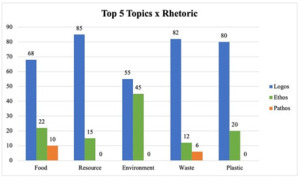
For food, resource, environment, waste, and plastic topics (the top five topics in sustainability communication), logos is always used the most often, then ethos second most often. Pathos is only shown above food and waste.
Positive and Negative Reinforcement
Once an audience understands the benefits of taking action, the behavior can be reinforced positively or negatively in the call to action. Reinforcement strategies are essential for encouraging and sustaining desired behaviors.
Positive Reinforcement involves rewarding desirable behavior to increase the likelihood of its recurrence. In a business context, this might include recognizing and rewarding employees or departments that excel in implementing sustainable practices. For example, a company establishes a “Green Champion” award, recognizing employees who make significant contributions to sustainability efforts, such as reducing waste or conserving energy. The recognition serves as positive reinforcement, encouraging others to follow suit. [32] Tesco incentivizes suppliers to make positive changes to their business while tracking performance to offer its supply base sustainability-linked supply chain finance. [33]
Negative Reinforcement involves removing an unpleasant condition after a desired behavior occurs to encourage the behavior. This strategy can be less common but still effective in certain scenarios. [34] A firm might implement policies that reduce workload or offer extra leave to employees who actively participate in sustainability projects, thereby removing the burden of additional work as a form of negative reinforcement. The example above about Salesforce insisted that suppliers maintain a sustainability scorecard or risk paying a “climate remediation fee.” [35]
Below is a visual of operant conditioning, otherwise known as “behavior controlled by its consequences.” [36] The visual describes the differences between reinforcement and punishment. The footnote describes it in more detail. We will focus on positively reinforcing others to make changes in this textbook by instilling positive emotions to change, such as hope, over negative emotions, such as irritation and fear.
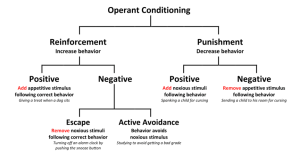
Overview of the Diagram
- Operant Conditioning (Title)
- The topmost label indicating the overall concept of the diagram.
- Reinforcement (Increase behavior):
- Positive Reinforcement: Adding an appetitive stimulus following correct behavior to increase the likelihood of the behavior occurring again.
- Example: Giving a treat when a dog sits.
- Negative Reinforcement: Removing a noxious stimulus following correct behavior to increase the likelihood of the behavior occurring again.
- Escape: Removing a noxious stimulus following correct behavior.
- Example: Turning off an alarm clock by pushing the snooze button.
- Active Avoidance: Behavior avoids noxious stimulus.
- Example: Studying to avoid getting a bad grade.
- Escape: Removing a noxious stimulus following correct behavior.
- Positive Reinforcement: Adding an appetitive stimulus following correct behavior to increase the likelihood of the behavior occurring again.
- Punishment (Decrease behavior):
- Positive Punishment: Adding a noxious stimulus following behavior to decrease the likelihood of the behavior occurring again.
- Example: Spanking a child for cursing.
- Negative Punishment: Removing an appetitive stimulus following behavior to decrease the likelihood of the behavior occurring again.
- Positive Punishment: Adding a noxious stimulus following behavior to decrease the likelihood of the behavior occurring again.
Examples Using Positive Reinforcement and Negative Reinforcement in Ads
Example Using Positive Reinforcement
Below is an ad for the Rainforest Alliance that says “Pessimism is out. We’re all in.” A young girl is handing bananas to an older man. It is a campaign that makes the audience feel positive about taking action and supporting the Rainforest Alliance. [38]
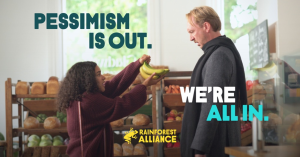
Structure and Examples:
- Reinforcement and Punishment are the primary categories.
- Each category is further divided into Positive and Negative methods.
- Positive Reinforcement involves adding something desirable.
- Negative Reinforcement involves removing something undesirable.
- Includes subcategories of Escape and Active Avoidance.
- Positive Punishment involves adding something undesirable.
- Negative Punishment involves removing something desirable.
Examples Provided:
- Positive Reinforcement: Giving a treat when a dog sits.
- Escape (Negative Reinforcement): Turning off an alarm clock by pushing the snooze button.
- Active Avoidance (Negative Reinforcement): Studying to avoid getting a bad grade.
- Positive Punishment: Spanking a child for cursing.
- Negative Punishment: Sending a child to his room for cursing.
Example Using Negative Reinforcement
Below is an example of a Super Bowl ad in the U.S. from the nonpartisan group Science Moms. It showed young children growing into adults, with the narrative emphasizing the rapidly changing and potentially dire world they will face due to climate change. It highlights the “vulnerability” of future generations and connects climate impacts to personal milestones, making time feel scarce. It inspires the audience to take action in order to avoid the negative future consequences.
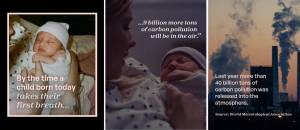
This image has three panels. The first on the left has a baby being held by a mother, and the text in pink, “By the time a child born today takes their first breath…” The second panel in the middle shows the mother and baby with grey text on a darker background, “9 billion more tons of carbon pollution will be in the air.” The final panel on the right has a factory building with smoke filling the air and pink text saying “Last year more than 40 billion tons of carbon pollution was released into the atmosphere” with “World Meteorological Association” as its source.
Why Focus on Positive Reinforcement?
Studies have shown two different rhetorical styles of communicating sustainability to the public: “sunny side” and “dark side”. Since marketing and social media tend to be for entertainment, they will grab attention and call audiences to action in ways that is meant to be fun. Still, only talking about the “sunny side” of sustainability doesn’t seem to work because it only gives one half of the story. When we move toward sustainable development, we have to make big changes that can mean sacrificing resources and making drastic changes in our daily lives. We also have to leave behind old traditions that used to work in the economy, which means sharing bad news and tough messages. Because of this, it is still important to show the “dark side” of sustainability in messages to be seen as a reliable source of information about and for sustainability. It is also recommended to use stronger emotional pleas like pathos in this case, since “communication and behavior are interconnected and behavior cannot change without proper communication.” [40]
Application of Motivation, Benefits, and Reinforcement in Business Sustainability
To effectively persuade stakeholders to embrace sustainability, businesses must strategically combine these motivational and reinforcement approaches. Here are a few practical steps:
- Communicate Intrinsic Rewards: Highlight the personal satisfaction and ethical fulfillment that comes with sustainable practices. For instance, share stories of employees who feel proud and motivated by their contributions to the company’s environmental goals.
- Showcase Tangible Benefits: Present clear data and examples of cost savings and efficiency gains from sustainability initiatives. Regularly report on energy savings, waste reduction, and other measurable outcomes to make a compelling financial case.
- Emphasize Intangible Benefits: Use case studies and testimonials to illustrate how sustainability enhances brand reputation and customer loyalty. Demonstrate how these intangible benefits contribute to the company’s long-term success and market position.
- Implement Positive Reinforcement Programs: Develop recognition and reward programs that celebrate sustainability achievements. Create incentives that align with employees’ values and motivations, such as public acknowledgment, bonuses, or additional leave.
- Utilize Negative Reinforcement Tactically: Identify areas where removing barriers or unpleasant conditions can promote sustainable behaviors. For example, streamline processes or reduce administrative burdens for teams that actively participate in sustainability projects.
Strengthening Arguments for Skeptical Audiences
In addition to including a range of appeals and benefits in a persuasive message about planetary sustainability, it is crucial for the arguments in a persuasive message to be logically sound. This requires a careful examination of what to avoid, such as logical fallacies, and what to include, such as well-structured counterarguments and refutations. By understanding these elements, we can ensure our messages are not only compelling but also logically robust. Therefore, the next step is to delve into the identification and avoidance of logical fallacies, followed by strategies for crafting effective counterarguments and refutations to improve credibility and persuasiveness of our communications.
Logical Fallacies
Logical fallacies are errors in reasoning that weaken arguments. The word “fallacy” means “it is false.” Although you may hear fallacies frequently in the news and social media, using fallacies in arguments makes the argument weaker. Understanding and identifying what fallacies are can improve the credibility of your arguments. [41]
Two types of logical fallacies include formal and informal. Formal Fallacies follow a flawed logical structure, such as non-sequitur (it does not follow) and post hoc (also known as “correlation versus causation,” meaning something happened after this, therefore it happened because of this). Informal Fallacies have a flawed substance of the argument, including the examples below:
Examples of Informal Fallacies
- Circular Argument: Restating the premise instead of proving it.
- False Dilemma: Presenting only two options when more exist.
- Hasty Generalization: Drawing conclusions from insufficient evidence.
- Equivocation: Using ambiguous language to mislead.
- Ad Hominem: Attacking the person instead of the argument.
- Slippery Slope: Suggesting a minor step will lead to major consequences.
- Sweeping Generalization: Making broad statements based on limited evidence. [42]
Below are common logical fallacies about climate change as examples [43]:
Climate Myth Fallacies
| Fact | Myth | Fallacy |
| Global warming is like rigging the weather dice, making it more likely to get hot days. | It’s cold outside, so global warming must have stopped. | False Expectations: global warming doesn’t mean no more cold weather, just less cold days compared to hot days |
| Overall, glaciers across the globe are shrinking at an accelerating rate, threatening water supplies for millions of people. | Glaciers around the world are increasing, disproving global warming. | Cherry picking: picking a handful of growing glaciers ignores most glaciers that are shrinking. |
| The West Antarctic ice sheet is losing hundreds of billions of tons of ice every year, making it a major contributor to global sea level rise. | Antarctic sea ice is on the increase and casts doubt on global warming. | Oversimplification: Antarctic sea ice behavior is influenced by many factors, and short-term regional trends do not contradict long-term global climate change. |
| We can measure temperature in many ways and they all say the same thing – our planet is warming. | The thermometer record is unreliable and not accurate or have sufficient coverage to detect global warming. | Jumping to conclusions: just because measurements have “error” or uncertainty doesn’t mean it’s unknowable. The uncertainty is smaller than the measured global warming. |
| If we stopped emitting CO2, it would take thousands of years for the atmosphere to return to pre-industrial levels | CO2 has a residence time of only 4 years so CO2 levels would fall quickly if we stopped emitting. | Red herring: residence time is how quickly a CO2 molecule moves around the climate system but that’s different to how long it takes CO2 level to return back to normal. |
| Ice core record tells us warming causes the ocean to emit more CO2. Combined with greenhouse effect, this is a reinforcing feedback. | CO2 lagging temperature means greenhouse effect is minimal. | False dichotomy: it’s not one or the other but both |
Counterarguments and Refutations
A counterargument acknowledges opposing viewpoints and then reaffirms your argument. This technique shows you have considered multiple sides and can strengthen your position. [44] For example, if writing a persuasive message to an employer to stop animal testing in their organization, several paragraphs would rationalize one’s point of view of animal testing, then another paragraph would begin with a counterargument and refutation, then the call to action (to stop animal testing). The counterargument could include the following:
Counterargument example: Some people argue that using animals as test subjects for health products is justifiable. To be fair, animal testing has been used in the past to aid the development of several vaccines, such as small pox and rabies.
Refutation example: However, animal testing for beauty products causes unneeded pain to animals that humans would not subject themselves to. Westmoreland (2006) suggests that alternative methods to animal research are being developed; for example, researchers are able to use skin constructed from cells to test cosmetics. If alternatives to animal testing exist, then the practice causes unnecessary animal suffering and should not be used.
This refutation is strong for addressing this specific counterargument, not another one. The following are bad examples of refutations:
- However, they’re wrong (blanket argument).
- However, animal labor is wrong (refuting a different argument).
- A logical fallacy from above.
Here are some ways to introduce a counterargument to my own argument:
- Counterargument: Some people believe that … Some may argue that… You may be thinking that…
- Here are some ways to directly and clearly introduce a refutation to this counterargument:
- Refutation: However, … On the other hand…Although that may be true….
Your paragraph would then go on to explain more about this position; you would give evidence here from your research about the point of view of your own opinion.
Conclusion
Persuasion is a powerful tool in business sustainability, essential for motivating change, building support, and overcoming resistance. By understanding and applying concepts of intrinsic and extrinsic motivation, tangible and intangible benefits, and positive and negative reinforcement, businesses can effectively persuade stakeholders to embrace and sustain environmentally friendly practices. Putting a variety of these elements in the right order can save audiences time in finding the information and taking action. These strategies not only drive immediate behavior changes but also foster a culture of sustainability that aligns with long-term business success and inspire collective action towards a more sustainable future.
[1] Newman, A. (2022). Business Communication and Character (11th Edition). Cengage South-Western.
[2] The 5 steps of persuasion: all you need to know. (2019, November 26). Bookboon. https://bookboon.com/blog/the-5-steps-of-persuasion-all-you-need-to-know/#:~:text=In%20the%201930s%2C%20John%20Monroe,%2C%20Satisfaction%2C%20Visualization%20and%20Action
[3] Vandenbergh, M. P., & Gilligan, J. M. (2017). Beyond politics: The private governance response to climate change. Cambridge University Press.
[4] Kotler, P., & Lee, N. (2011). Social marketing: Influencing behaviors for good. Sage.
[5] Gifford, R., & Chen, A. (2017). Why aren’t we taking action? Psychological barriers to climate-positive food choices. Climatic Change, 140(2), 165-178. https://doi.org/10.1007/s10584-016-1830-4
[6] Moser, S. C. (2016). Communicating climate change: history, challenges, process and future directions. Wiley Interdisciplinary Reviews: Climate Change, 1(1), 31-53. https://doi.org/10.1002/wcc.11
[7] Du, S., & Vieira Jr, E. T. (2012). Striving for legitimacy through corporate social responsibility: Insights from oil companies. Journal of Business Ethics, 110(4), 413-427. https://doi.org/10.1007/s10551-012-1490-4
[8] Porter, M. E., & Kramer, M. R. (2011). Creating shared value. Harvard Business Review, 89(1/2), 62-77.
[9] Austin, J. E., & Seitanidi, M. M. (2012). Collaborative value creation: A review of partnering between nonprofits and businesses: Part I. Value creation spectrum and collaboration stages. Nonprofit and Voluntary Sector Quarterly, 41(5), 726-758. https://doi.org/10.1177/0899764012450777
[10] Corporate Sustainability Management. Section 4.1: Balancing the Pillars of sustainable development. https://csmathsg.com/course-content/week-4/section-4-1-balancingthe-pillars-of-sustainable-development/. Last accessed March 2023.
[11] Aguinis, H., & Glavas, A. (2012). What we know and don’t know about corporate social responsibility: A review and research agenda. Journal of Management, 38(4), 932-968. https://doi.org/10.1177/0149206311436079
[12] Seuring, S., & Müller, M. (2008). From a literature review to a conceptual framework for sustainable supply chain management. Journal of Cleaner Production, 16(15), 1699-1710. https://doi.org/10.1016/j.jclepro.2008.04.020
[13] Eccles, R. G., Ioannou, I., & Serafeim, G. (2014). The impact of corporate sustainability on organizational processes and performance. Management Science, 60(11), 2835-2857. https://doi.org/10.1287/mnsc.2014.1984
[14] Yaziji, M., & Doh, J. (2009). NGOs and Corporations: Conflict and Collaboration. Cambridge University Press.
[15] Singh, J., Iglesias, O., & Batista-Foguet, J. M. (2012). Sustainability orientation and market performance: The moderating effect of stakeholder engagement. Journal of Business Ethics, 107(2), 207-219. https://doi.org/10.1007/s10551-011-1034-4
[16] Gardberg, N. A., & Fombrun, C. J. (2006). Corporate citizenship: Creating intangible assets across institutional environments. Academy of Management Review, 31(2), 329-346. https://doi.org/10.5465/amr.2006.20208684
[17] Etzkowitz, H., & Leydesdorff, L. (2000). The dynamics of innovation: From National Systems and “Mode 2” to a Triple Helix of university–industry–government relations. Research Policy, 29(2), 109-123. https://doi.org/10.1016/S0048-7333(99)00055-4
[18] Clancy, H. (2025). Salesforce got key suppliers to promise emissions cuts. Here’s how. Trellis. From https://trellis.net/article/salesforce-got-key-suppliers-to-promise-emissions-cuts-heres-how/
[19] Tesco set to become first UK retailer to offer sustainability-linked supply chain finance. (2021). Tesco. From https://www.tescoplc.com/tesco-set-to-become-first-uk-retailer-to-offer-sustainability-linked-supply-chain-finance/
[20] Ourgoodbrands. (2023, October 28). Using persuasion to make the world more sustainable. Ourgoodbrands. https://ourgoodbrands.com/using-persuasion-to-make-the-world-more-sustainable
[21] Telling your sustainable packaging story: A complete guide. (n.d.). Eco Enclose. From https://www.ecoenclose.com/marketing-assets
[22] Monroe, A. H. (1935). Principles and Types of Speech. Scott, Foresman.
[23] Riley, D. (2023, April 20). Motivated Sequence Still Bewitching Audiences. https://www.linkedin.com/pulse/motivated-sequence-still-bewitching-audiences-dan-riley/
[24] Cardon, P. (2018). Business Communication: Developing Leaders for a Networked World, 3rd ed. New York: McGraw Hill Education.
[25] Rentz, K., & Lentz, P. (2018). Business Communication: A Problem-Solving Approach. New York: McGraw Hill.
[26] Patagonia
[27] Deci, E. L., & Ryan, R. M. (1985). Intrinsic Motivation and Self-Determination in Human Behavior. Springer.
[28] Ryan, R. M., & Deci, E. L. (2000). Intrinsic and extrinsic motivations: Classic definitions and new directions. Contemporary Educational Psychology, 25(1), 54-67. https://doi.org/10.1006/ceps.1999.1020
[29] Ryan, R. M., & Deci, E. L. (2000). Intrinsic and extrinsic motivations: Classic definitions and new directions. Contemporary Educational Psychology, 25(1), 54-67. https://doi.org/10.1006/ceps.1999.1020
[30] Aristotle. (2007). On Rhetoric: A Theory of Civic Discourse (G. A. Kennedy, Trans.). Oxford University Press. (Original work published ca. 350 B.C.E.)
[31] Voci, D. (2022). Logos, Ethos, Pathos, Sustainabilitos? About the Role of Media Companies in Reaching Sustainable Development. Sustainability, 14(5), 2591. https://doi.org/10.3390/su14052591
[32] Van den Broek, K. L. (2019). A review of behavior change techniques included in eco-feedback technologies: Opportunities for addressing sustainability. Current Opinion in Behavioral Sciences, 26, 60-65. https://doi.org/10.1016/j.cobeha.2018.10.019
[33] Tesco set to become first UK retailer to offer sustainability-linked supply chain finance. Tesco PLC. https://www.tescoplc.com/tesco-set-to-become-first-uk-retailer-to-offer-sustainability-linked-supply-chain-finance/
[34] Skinner, B. F. (1953). Science and Human Behavior. Macmillan.
[35] Nastu, J. (2021). Salesforce suppliers must maintain sustainability scorecard or pay ‘Climate Remediation Fee.’ Environment + Energy Leader. https://www.environmentenergyleader.com/2021/04/salesforce-suppliers-must-maintain-sustainability-scorecard-or-pay-climate-remediation-fee/
[36] Staddon, J. E., Cerutti, D. T. (2002). Operant conditioning. Annu Rev Psychol, 54, 115-44. doi: 10.1146/annurev.psych.54.101601.145124
[37] Baker, J., & Baker, J. (2024, July 4). What Is Negative Reinforcement? Examples & Benefits. SplashLearn Blog – Educational Resources for Parents, Teachers & Kids. https://www.splashlearn.com/blog/how-is-negative-reinforcement-for-kids-a-great-strategy-when-used-right/
[38] Sherrif, S. (2023). ‘Pessimism is out’: Cynic-busting Rainforest Alliance campaign inspires action. Marketing / Beat. From https://www.marketing-beat.co.uk/2023/11/15/rainforence-alliance-optimism/
[39] Kayhoe, K. (2025). A Climate Ad that Reached Millions. Talking Climate. From https://www.talkingclimate.ca/p/a-climate-ad-that-reached-millions
[40] Karmasin, M., Voci, D., Weder, F., Krainer, L. (2021). Future perspectives: Sustainability communication as scientific and societal challenge. In The Sustainability Communication Reader: A Reflective Compendium; Weder, F., Krainer, L., Karmasin, M., Eds.; Springer: Wiesbaden, Germany, 2021; pp. 585–591. [Google Scholar]
[41] Types of Logical Fallacies: Recognizing Faulty Reasoning. (2021). In YourDictionary. https://examples.yourdictionary.com/examples-of-logical-fallacy.html
[42] Find more fallacies online such as https://iep.utm.edu/fallacy/
[43] Climate Myth Fallacies. (n.d.). Skeptical Science. https://skepticalscience.com/fallacies.shtml
[44] Counterarguments | University Writing & Speaking Center. (n.d.). University of Nevada, Reno. https://www.unr.edu/writing-speaking-center/student-resources/writing-speaking-resources/counterarguments